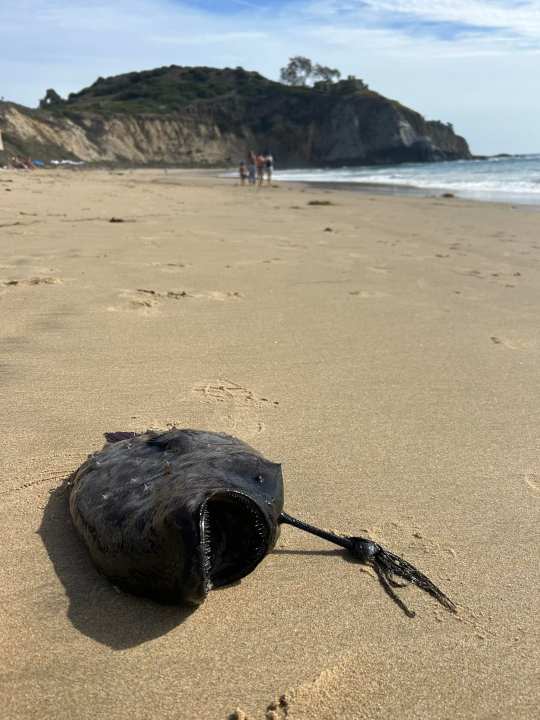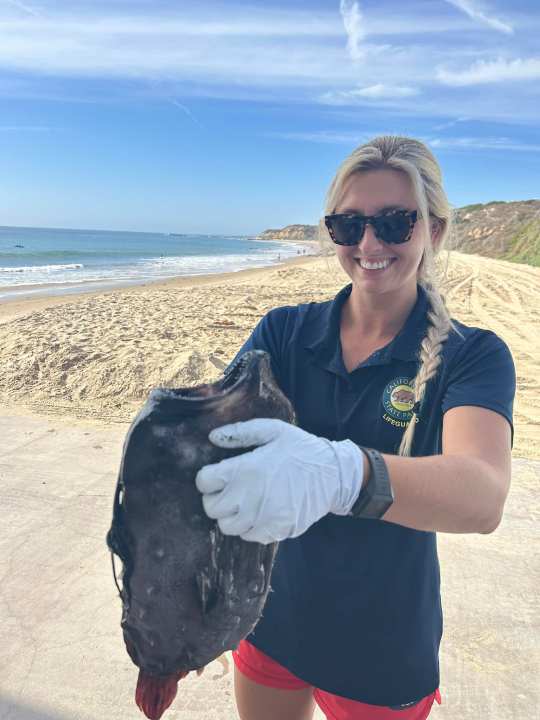Ghoulish deep-sea fish found on California beach in rare discovery

SAN DIEGO (KSWB) – For the second time in three years, a ghoulish, reclusive species of deep-sea fish washed ashore on a beach in Orange County, California.
Seasonal lifeguard at Crystal Cove State Park Sierra Fockler discovered a deep-sea anglerfish lying on the shore of Moro Beach near the lifeguard headquarters earlier this month. The discovery was made just in time for Friday the 13th, and the park later shared the pictures of the find on social media.
VIDEO: Dolphins swim through bioluminescent waters in Orange County
With a gaping mouth and spiny fin, the specimen, identified as a Pacific footballfish, was the same species as the anglerfish discovered by a Moro Beach visitor in May 2021. The specimen found in May 2021 is currently at the Natural History Museum of Los Angeles.
Lifeguards estimate that the latest specimen, which was found intact but deceased, washed up with the morning high tide, at around 9 a.m. Officials with the California Department of Fish and Wildlife picked it up shortly after for further research.
A Pacific Footballfish was discovered on the shores of Crystal Cove State Park on Oct. 13, 2023. (Courtesy of California State Parks) Seasonal lifeguard Sierra Fockler with a Pacific Footballfish discovered on the shores of Crystal Cove State Park on Oct. 13, 2023. (Courtesy of California State Parks)
According to state park officials, there are more than 200 species of anglerfish worldwide. The Pacific footballfish, which some may know as one of the creatures depicted in the movie “Finding Nemo,” is the largest species of anglerfish and resides at depths of around 2,000 to 3,000 feet.
Female Pacific footballfish possess a long stalk on the top of their head that has a bioluminescent tip used to lure prey in pitch-black water. Experts say their mouth — full of pointed, glass-like teeth — is capable of sucking up and swallowing prey as large as their body, which can reach lengths of up to 24 inches.
Males, on the other hand, never grow beyond about an inch long, with their sole purpose being to find a female to help her reproduce.
“Males latch onto the female with their teeth and become ‘sexual parasites,’ eventually coalescing with the female until nothing is left of their form but their testes for reproduction,” officials with Crystal Cove State Park wrote.
The specimen discovered on Oct. 13 is likely a female, given its size and the presence of the luminescent stalk on the top of its head.
While they’re a common species in the depths of the ocean, experts say it’s extremely rare to see an actual anglerfish intact above shore.
“We don’t know a whole lot about these specimens, because we don’t see them all the time and that’s what makes them so mysterious,” Dr. William Lundt, assistant curator of ichthyology at the Natural History Museum of Los Angeles, said to Spectrum News 1 after the 2021 discovery.
PHOTOS: Velella velellas, or By-the-Wind sailors, spotted on San Diego beaches
Aside from the anglerfish discovered this month, there are only about 31 complete adult female specimens of this species that exist in museums across the world, according to Lundt.
The 31st was discovered in December 2021 on the shores of Encinitas. It was the third to be found in California that year.
It is unknown exactly how any of the deep-sea creatures ended up on land.
“Seeing this strange and fascinating fish is a testament to the curious diversity of marine life lurking below the water’s surface in California’s Marine Protected Areas,” park officials said, “and as scientists continue to learn more about these deep-sea creatures, it is important to reflect on how much is still to be learned from our wonderful and mysterious ocean.”
For the latest news, weather, sports, and streaming video, head to KTLA.



